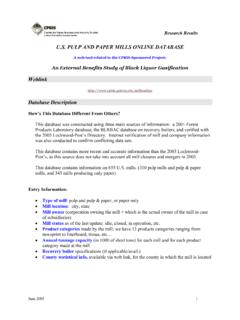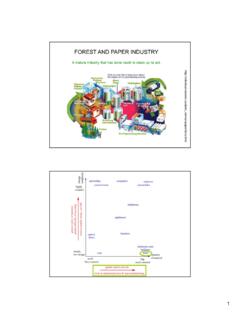Transcription of Supply Chain Management in the Pulp and Paper Industry
1 Supply Chain Management in the pulp and Paper Industry Dick Carlsson S dra Cell International AB, SE-351 89 V xj , Sweden Sophie D Amours FOR@C, CIRRELT, Universit Laval, G1K 7P4, Qu bec, Canada Alain Martel FOR@C, CIRRELT, Universit Laval, G1K 7P4, Qu bec, Canada Mikael R nnqvist The Norwegian School of Economics and Business Administration, NO-5045 Bergen, Norway October 2006 Working Paper DT-2006-AM-3 Interuniversity Research Center on Enterprise Networks, Logistics and Transportation (CIRRELT), Universit Laval, Qu bec, G1K 7P4, Canada CIRRELT, 2006 Supply Chain Management in the pulp and Paper Industry DT-2006-AM-3 1 Abstract The pulp and Paper Industry depends on a long and integrated Supply Chain .
2 It starts in forest harvest areas as trees and ends as multiple products used in all persons daily usage. The lead time from the first step to the last is long and it involves many steps operated by several companies and organizations. In this overview Paper we describe the overall Supply Chain , its participants and the planning problems arising along the Chain . We divide the planning problems into strategic, tactical and operative in a Supply Chain matrix and describe their characteristic and provide applications as illustrations.
3 We discuss the need for information and decision support for planners in each of these areas. This relates to planning within a single company as well as integrated planning across several. A number of tailor-made systems has been developed and published in the literature and we describe these tools/systems together with their characteristics and results. To conclude with a discussion around current issues and outline future research areas. Supply Chain Management in the pulp and Paper Industry DT-2006-AM-3 2 1.
4 Introduction The pulp and Paper Industry produces a great number of Paper and other cellulose based fibre products. The total quantity of cellulose-based products consumed every year world-wide exceeds 360 million tonnes. News papers, copy papers, various types of tissue, bottle labels, cigarette papers, and coffee filters are just a few examples of products regularly used in our everyday life. There is a large number of activities involved in the Chain behind these products; from planting of the seeds of the trees producing the cellulose, until the product is used by the final consumer, and subsequently disposed of or recycled.
5 Such a network of activities is known as a Supply Chain (SC) in the Management and operations research literature. The interest for the Supply Chain perspective has increased over the recent years. Information systems, such as Enterprise Resource Planning (ERP) systems, are now crucial for the Management of most companies by providing updated information about the various parts of the Chain within a company. The information flow between organizations is an area which still needs further attention.
6 Having information available is, however, not sufficient for appropriate Management . Managing the Supply Chain involves a great deal of planning on different levels. Many of the ERP-systems offer some planning and decision support, and in addition there are commercial packages specialized for the purpose. However, commercially available planning support is not able to deal with all the planning problems of the pulp and Paper Supply Chain . In addition there are research and development projects reported in the Operations Research (OR) literature to support the development of advanced Decision Support Systems (DSS).
7 Stadtler and Kilger (2005) provide an overview of Supply Chain Management and planning systems. They give definitions and describe the structure of the Supply Chain . Different advanced Supply Chain planning concepts are explored and different commercial advanced planning and scheduling systems (APS) are given as examples. The authors also give some implementation examples, however not from the pulp and Paper Industry . Stadtler (2004) also gives a, condensed, overview of Supply Chain planning and Management .
8 Recommendations for the future development of advanced planning systems are also offered. Demand planning is identified as being crucial for the Supply Chain planning and it is stated that models used so far could be improved. Another potential improvement is support for lot-sizing Supply Chain Management in the pulp and Paper Industry DT-2006-AM-3 3 decisions in the master planning, which is claimed to be not fully solved yet.
9 The author likes to see examples of event based planning being implemented which could prevent everything from being re-planned when the planning horizon is moved forward. Stadtler also identify uncertainty as a weakness in the Supply Chain planning of current APS. In the case of the pulp and Paper Industry , uncertainty at the Supply level adds complexity as compared to discrete manufacturing. This because the properties of the logs (which in fact is unique for each) is not known until the harvesting is carried out.
10 The fact that the production is a many-to-many process is another particularity which added to this uncertainty at the Supply and demand level raises the complexity of the problem. R nnqvist (2003) and Weintraub and Romero (2006) gives examples of how optimization models and techniques have been used to solve Supply Chain planning problems arising in forestry. The reviews include forest Management , harvesting, and transportation to wood consuming industries. The former also includes also examples of production and distribution planning at saw and pulp mills.










